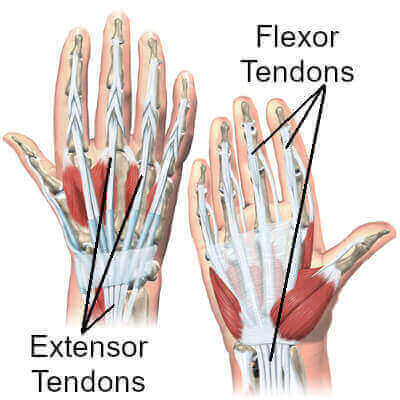What is Wrist Tendonitis Pain?
Overview
Wrist tendonitis is a common hand disorder. Wrist tendonitis
pain
is just one sign of this condition. Knowing all of the the signs and symptoms is important if you want to treat wrist tendonitis effectively. People commonly use the term
wrist tendonitis to describe tendon inflammation around the wrist joint. But either the
flexor
or
extensor
tendons (bottom or top of the hand, respectively) may be causing the problem. When there's a problem with these tendons, they can produce different symptoms around the hand or wrist area. So if you have finger, hand or wrist pain, it’s important to recognize the symptoms below in order to treat them.
First, how wrist tendonitis happens
Tendonitis literally means "tendon inflammation". It can occur at various locations in the body – actually, anywhere you have tendons. The name of the condition refers to its location, such as wrist tendonitis,
elbow tendonitis,
shoulder tendonitis,
Achilles tendonitis, etc.
Your tendons are the thick cords which connect muscles to bones. The tendons naturally stretch and contract with each joint's motion. And since tendons are almost constantly in motion, you can injure them suddenly or gradually.
A sudden stretch can pull tendons quickly and with a lot of force. Often this happens with weightlifters and runners. But you can make many smaller movements over a long period of time that can also cause tendon strain and inquiry. This is called repetitive strain or
repetitive stress injury. (Some simply call it "RSI".)
Whether the tendonitis was caused suddenly or by repetitive stress, the symptoms are identical. When tendonitis results from repetitive motions, it usually develops over a very long period of time. In fact, it may take many months of repetitive finger or hand movement to cause wrist tendonitis.
Moreover, if the initial strain doesn’t heal, wrist tendons may
re-strain over and over again. Think of it as continuous re-injury to the tendon. Eventually, long-term strain produces tiny scars and
adhesions on the tendon. This is
chronic wrist tendonitis and it produces long-lasting inflammation and pain.
Wrist tendonitis pain & other symptoms
With any symptom of wrist tendonitis, either the extensor or flexor tendons are affected. Symptoms can occur anywhere along the tendon's length; from the forearm to the fingertips.
- With
extensor tendonitis such sensations usually occur on the
top
of the arm and hand.
- With
flexor tendonitis the same sensations generally occur on the
palmar surface of the arm and hand.
Any symptom can range from mild to severe. It's also possible to have symptoms on the extensor and flexor tendons simultaneously, although that's uncommon.
Most wrist tendonitis results from an activity that's easily identified. In other words, there's no mystery where it came from. Jackhammer operators, construction laborers, weightlifters, assembly line workers,
hairdressers, and
graphic designers all perform repeated or forceful hand or finger motions. It's no wonder these workers are also at the highest risk for inviting wrist tendonitis pain.
Pain
If left untreated, chronic wrist tendonitis pain becomes more intense when you move your wrist joint or finger. But at rest, it feels normal. That’s one of the
main distinguishing signs of wrist tendonitis compared to
carpal tunnel syndrome. The pain usually feels like a dull ache, but sharpens as the joint moves more.
The pain can occur anywhere from the fingers to the mid-forearm.
Grinding
In addition to pain, there may be a sensation of grinding or creaking (immediately on top of the tendon) as you move a finger. Some people describe it as burning sensation or sandpaper rubbing.
Inflammation
Like most injuries, wrist tendonitis results in
inflammation and swelling. You can usually feel this as warmth and redness on the skin surface over the tendon. And the area is usually very tender to the touch. This inflammation usually reduces your wrist's mobility. The tenderness is another
main distinguishing sign compared to carpal tunnel syndrome: intense wrist tendonitis pain usually results when
touching
the inflamed area.
Weakness, numbness or tingling
Hand weakness, finger numbness, and tingling sensations are less common signs of wrist tendonitis. However, they can occur in conjunction with the pain symptom.
As mentioned above, all signs of wrist tendonitis worsen with joint movements that utilize that tendon. For example, someone with wrist tendonitis pain caused by repetitive keyboard use may also feel the same pain when setting the table for dinner or writing with a pen. The same hand and finger motions are used and therefore cause the same type of pain.
Treating MILD wrist tendonitis pain
Today, more people than ever are developing wrist tendonitis due to sitting at a computer workstation or texting frequently. But you can treat mild wrist tendonitis with good results using some simple techniques.
Note that chronic wrist tendonitis is usually harder to treat than a new episode.
However, most cases respond well to diligent and dedicated treatment. You can treat most cases of wrist tendonitis pain with:
- Rest
- Ice packs
- Non-steroidal anti-inflammatory (
NSAID ) drugs like Advil, Tylenol, Aleve or Motrin
In order to
avoid wrist tendonitis altogether, it’s important to properly adjust your work place. For example, ensure your computer keyboard and chair height don't cause neck or arm stresses.
First and foremost, don't lean or slouch when sitting.
Poor posture
produces unbalancing forces in the upper body that are transmitted to the wrist area. The result is pain.
When you’re typing, forearms and hands must be at the same height. Wrists are never bent forward or backward. Also when typing, your wrists should float above the keyboard, not lying on it. You can use a “wrist rest” to adjust the angle of your wrists and further reduce the possibility of developing even worse wrist tendonitis pain.
Also as you work, take frequent breaks to do
stretching exercises for the finger joints (which are most at risk). The stretching does two things. It loosens tendons and breaks up
microscopic adhesions that form inside the tendon and its sheath.
Here's an example of taking a
quick stretching exercise break. Let's say you're sitting at a computer workstation and typing at the keyboard. Every half hour, interlace your fingers and push your palms away from you. Then dangle your hands at your sides and shake them out to increase blood flow.
That's it!
Doing this will help prevent wrist tendonitis pain more than you can imagine.
Treating SEVERE wrist tendonitis pain
To treat severe wrist tendonitis, do everything you would do for mild symptoms as described above.
But also wear a
wrist brace while you sleep.
Most importantly,
do not
wear a brace while working with your hands.
If you wear a wrist brace while working, your hand will perform its regular tasks while
also
fighting the brace. That stresses wrist tendons even more. The exception to wearing a wrist brace during the day is when you expect to do
heavy lifting. In that case, a brace can prevent your hand from over-bending.
If pain is severe, over-the-counter NSAID pain medications are still a good solution. But the
FDA warns you should never use them on a chronic (continual) basis due to the possibility of liver and kidney damage.
Therefore, only take them when absolutely necessary.
For severe cases, physical therapy is the best remedy for eliminating wrist tendonitis pain, numbness, and other symptoms. Physical therapy helps strengthen muscles. And that helps strengthen and support the wrist joint and tendons.
Also, use
physical therapy massage in order to loosen restricted tendinous tissues in the wrist. That’s important because fundamentally, microscopic adhesions cause tendonitis. The massage breaks up those adhesions which then disappear.
Performing physical therapy on your own hand (with minimal instruction) can be successful in some cases. But there are limits to using only one hand to do so. For severe or chronic wrist tendonitis, seeing a trained physical therapist yields far better results.
Summary
Wrist tendinitis pain can be debilitating. Moreover, it can last for months if left untreated. Taking NSAID medicines every day is not the answer due to their toxicity.
About






